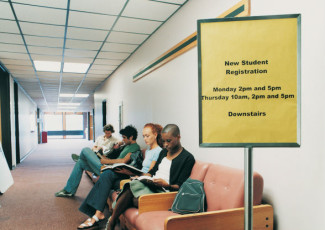Colleges Find Ways to Do More With Less
By Bob Woods
June 23, 2014
In the second installment of our two-part series, we highlight promising practices to help community colleges usher in important reforms in a time of limited resources.
Nobody said it would be easy.
When President Obama challenged the nation’s community colleges to do their part to help America double the number of college completers by 2020, his words set in motion a movement that would force the nation’s two-year career and technical colleges to rethink how they served the needs of students and communities.
It didn’t take long to realize that sweeping reforms were necessary. But making those changes in a climate of shrinking budgets and declining enrollments would require colleges to rethink more than just teaching and learning. The entire business of education would have to change.
In the first installment of our two-part series, Maintaining Reforms When Enrollments Drop, we examined the impact the economic recovery has had on the community college reform movement. Today, we profile creative ideas designed to help our institutions do more with less.
Planning ahead
In California, Folsom Lake College (FLC) and other community colleges are integrating a new state-mandated Student Success and Support Program. The effort provides an early registration option to students who carefully plan and communicate their academic goals to the college.
“We’re asking students to be more intentional and purposeful about their goal in enrolling in community college,” explains FLC president Rachael Rosenthal. As a reward, “Students who complete these steps get to register early.”
To help students offset the rising cost of college, FLC partnered with the Community College Consortium for Open Educational Resources (CCCOER), part of the Open Education Consortium (OEC). Launched at Foothill-De Anza Community College District in 2007, under the leadership of then-chancellor Martha Kanter (Kanter served as U.S. undersecretary of education from 2009 to 2013), CCCOER is a multistate collaboration that encourages community colleges to create and share open educational resources (OERs), such as online textbooks and learning management systems.
“One of the ways community colleges can address expenses for students is to look at how to make instructional materials, especially textbooks, low cost or free,” says Una Daly, OEC’s community college outreach manager. The organization has found success by producing materials under Creative Commons licensing, a form of copyright that allows artists, educators and others to more widely share content in print and across the web.
Web access to digital content is less expensive than traditional print materials, although low-cost printed OERs are also available.
“Our mission is to expand access to education by promoting adoption of high-quality OERs,” Daly says. CCCOER hosts professional development workshops and webinars intended to help educators see the value of these resources.
Supporters say the consortium illustrates how powerful partnerships can be and what community colleges can accomplish when they work together.
Shared responsibility
That’s been the experience in Virginia, where the state’s 23 community colleges have turned to technology and shared services as a means of overcoming ongoing budget and enrollment challenges.
The Virginia Community College System (VCCS) is two-thirds of the way into Achieve 2015, a statewide initiative intended to boost student success while keeping a lid on college costs. That program has fueled a change in thinking across the system.
“The first 50 years of our existence, the narrative was on access, making sure people can get into colleges,” says Jeff Kraus, assistant vice chancellor for public relations for VCCS. “Now, the focus is on helping students successfully get out, making sure they leave with a credential that prepares them either for the senior institutions or the workplace.”
VCCS added 50,000 students statewide during the recession — all while coping with more than $100 million in cuts. Like a lot of community colleges, VCCS says enrollments are down in recent years, which has only prompted further belt tightening.
That’s where the idea for shared information technology came in. Rather than purchase technology for a single campus, the system opted to pool its resources to negotiate lower prices with vendors. The concept evolved from there.
“We call the initiative ‘enterprise operations’,” explains Joy Hatch, VCCS’s vice chancellor for information technology. Rather than continue to run IT piecemeal from campus to campus, the system centralized the majority of its operations. “All our colleges connect to our PeopleSoft ERP system,” Hatch says. The technology lets the system run campus business operations from its central office in Richmond. “We do the same with our learning management system, Blackboard,” Hatch says. She estimates the process has saved the state’s community colleges more than $20 million to date.
But it’s not just about savings. Added efficiencies allow campus IT administrators to spend less time integrating business systems and more time working with students and faculty to boost teaching and learning.
The program’s success has led to the centralization of other services across the system, including phone, security and, in some cases, financial aid.
“One of our colleges is processing all the financial aid paperwork for 10 of our other colleges, so financial aid officers have more time to meet with students,” Hatch says. Virginia’s community colleges have seen an increase in the number of student aid applications filed and the number of students who receive awards.
Extended reach
In addition to creating efficiencies, better use of technology has helped colleges reach more students.
Northern Virginia Community College (NOVA), Virginia’s largest community college, launched its Extended Learning Institute to provide hard-to-get education in rural and remote communities.
The distance education programs are available to students at other VCCS colleges, many of which lack staff or resources to host certain courses, such as foreign language sections, on campus.
“The number of classes has grown tremendously,” Hatch says. In addition to NOVA, other colleges have begun adding courses to the network.
Working with industry
Using technology and combining resources within the college system is one way to make do with less. Another option is to look outside the college for partners in the private sector.
The Community College/Career Collaboration (C4), launched in 2009 by the American Association of Community Colleges, Goodwill Industries International, the Aspen Institute and Jobs for the Future, provides job training for the underemployed.
Nationwide, more than 70 Goodwill centers have partnered with nearly 120 community colleges to share costs, equipment, facilities and faculty to staff local job-training efforts through C4.
Forsyth Technical College (FTC), in Winston-Salem, N.C., develops the curriculum and supplies the faculty for professional training programs hosted at local Goodwill centers.
“Goodwill provides wraparound services that we don’t offer, such as transportation, child care and housing,” says Alan Murdock, FTC’s vice president of economic and workforce development. “We also teach soft skills, including resume writing, interviewing skills and how to dress for success. Together, we’re leveraging everything we have to make our students as successful as possible.”
For more examples of how the nation’s community colleges are partnering to do more with less, don’t miss Empowering Community College’s to Build the Nation’s Future: An Implementation Guide, the companion to AACC’s 2012 report, Reclaiming the American Dream: Community College’s and the Nation’s Future.
If you missed part one of our series, read it now.













